MIARforest Reproducibility and Reliability for Assessing Occupational Risks in the Rainforest
Abstract
1. Introduction
2. Materials and Methods
2.1. MIARforest—Short Presentation
2.2. Data Collection
- Infrastructure construction—At this stage, vegetation is removed from the areas to be used for both the log yard and the roadways previously planned for different types of vehicles. To avoid accidents caused by tyre punctures, the roots are also uprooted.
- Planned felling and cross-cutting of logs—This phase involves the planned felling of trees with a previously defined diameter and in accordance with technical guidelines, followed by the cross-cutting of the tree tops.
- Skidding planning/Obstacle crosscutting activity—This operation defines the paths along which the tractor will drag the logs; then, all obstacles that might hinder the operation of the equipment are removed.
- Crosscutting—This process consists of cutting the treetops and sectioning the trunks of the trees. Generally, the cutting of the trunk is undertaken with a chainsaw to facilitate its dragging, as well as cutting the bases of the logs that have machetes or hollows.
- Skidding—involves moving the cut wood logs from the felling site to the storage yards.
- Cubage and stacking—This activity includes measuring the logs and confirming the species. The custody chain shown on the logging map is filled in. The logs are marked with an identification that allows their tracking according to commercial conformity. Then they are stored awaiting dispatch.
- Loading and transport—This stage consists of sorting of the species and loading the logs onto lorries to transfer them from the secondary parks to the central park. From the central park, the logs are then loaded for their final destination.
2.3. Applying Delphi
3. Results and Discussion
3.1. Other Approaches
3.2. MIARforest Reproducibility of the Results
3.3. Reliability of the Results
4. Conclusions
Author Contributions
Funding
Institutional Review Board Statement
Informed Consent Statement
Data Availability Statement
Acknowledgments
Conflicts of Interest
References
- FAO; UNEP. The State of the World’s Forests 2020—Forests, Biodiversity and People; FAO: Rome, Italy; UNEP: Nairobi, Kenya, 2020. [Google Scholar] [CrossRef]
- Gustafsson, L.; Baker, S.C.; Bauhus, J.; Beese, W.J.; Brodie, A.; Kouki, J.; Lindenmayer, D.B.; Lõhmus, A.; Pastur, G.M.; Messier, C.; et al. Retention Forestry to Maintain Multifunctional Forests: A World Perspective. BioScience 2012, 62, 633–645. [Google Scholar] [CrossRef]
- Lima, K.S.; Meira Castro, A.C.; Santos Baptista, J.; Silva, U. Wood-Logging Process Management in Eastern Amazonia (Brazil). Sustainability 2020, 12, 7571. [Google Scholar] [CrossRef]
- Ackerknecht, C. Occupational Accidents Footprint: New Concept linked to Chain of Custody in Sustainable Forest Management. Cienc. Trab. 2014, 16, 131–137. [Google Scholar] [CrossRef]
- Bermudes, W.; Barros, E. Work accident incidence rates from 2007 to 2013 in planted forests in the Brazilian states and the risks of this activity. Vértices 2016, 18, 53–64. Available online: https://editoraessentia.iff.edu.br/index.php/vertices/article/view/1809-2667.v18n216-04 (accessed on 19 July 2023). [CrossRef]
- Medeiros, J.; Jurado, S. Acidentes de trabalho em empresas florestais de plantio, cultivo e extração de madeira. Rev. Agrogeoambiental 2013, 5, 87–96. [Google Scholar] [CrossRef][Green Version]
- Viegas, J.; Freitas, L.; Santos, R.; Leite, A.; Fiedler, N. Work accidents in the Brazilian forest sector. Floresta 2017, 47, 561. [Google Scholar] [CrossRef]
- ILO—International Labour Organization. Safety and health in Forestry Work—ILO Codes of Practice. 1998. Available online: https://www.ilo.org/wcmsp5/groups/public/@ed_protect/@protrav/@safework/documents/normativeinstrument/wcms_107793.pdf (accessed on 23 June 2023).
- ILO Guidelines for Labour Inspection in Forestry. 2005. Available online: https://www.ilo.org/public/english/standards/relm/gb/docs/gb292/pdf/melif-gdln.pdf (accessed on 23 June 2023).
- Ackerknecht, C. Occupational Safety Indicators for Forest Operations, Sawmilling and Wood-Based Panels Manufacture; an International Benchmarking. Cienc. Trab. 2015, 17, 89–98. [Google Scholar] [CrossRef]
- Albizu-Urionabarrenetxea, P.M.; Tolosana-Esteban, E.; Roman-Jordan, E. Safety and health in forest harvesting operations. Diagnosis and preventive actions. A review. For. Syst. 2013, 22, 392–400. [Google Scholar] [CrossRef]
- Schettino, S.; Moraes, A.; Minette, L. Avaliação dos riscos ocupacionais aos trabalhadores da colheita florestal mecanizada. Nativa 2019, 7, 4. [Google Scholar] [CrossRef]
- Matsa, M.; Mandowa, J. Occupational safety and health problems in forest harvesting operations. Int. J. Dev. Sustain. 2015, 4, 359–380. Available online: https://isdsnet.com/ijds-v4n4-2.pdf (accessed on 23 June 2023).
- Unver, S.; Ergenc, I. Safety risk identification and prioritise of forest logging activities using analytic hierarchy process (AHP). Alex. Eng. J. 2021, 60, 1591–1599. [Google Scholar] [CrossRef]
- Camara, G.; Assunção, A.; Lima, F. The limitations of the traditional approach to work accidents: The case of timber exploitation in Minas Gerais, Brazil. Rev. Bras. De Saúde Ocup. 2007, 32, 41–51. [Google Scholar] [CrossRef]
- Conway, S.H.; Pompeii, L.A.; Casanova, V.; Douphrate, D.I. A Qualitative Assessment of Safe Work Practices in Logging in the Southern United States. Am. J. Ind. Med. 2017, 60, 58–68. [Google Scholar] [CrossRef]
- Enez, K.; Topbas, M.; Acar, H. An evaluation of the occupational accidents among logging workers within the boundaries of Trabzon Forestry Directorate, Turkey. Int. J. Ind. Ergon. 2014, 44, 621–628. [Google Scholar] [CrossRef]
- Heck, S.; Oliveira, L. Evaluation of health and safety at work: Chain saw operators in the region of Campos Gerais in state of Paraná. Espacios 2015, 36, 11–20. Available online: http://www.revistaespacios.com/a15v36n08/15360811.html (accessed on 23 June 2023).
- Lagerstrom, E.; Magzamen, S.; Rosecrance, J. A mixed-methods analysis of logging injuries in Montana and Idaho. Am. J. Ind. Med. 2017, 60, 1077–1087. [Google Scholar] [CrossRef] [PubMed]
- Melemez, K. Risk factor analysis of fatal forest harvesting accidents: A case study in Turkey. Saf. Sci. 2015, 79, 369–378. [Google Scholar] [CrossRef]
- Bermudes, W.L.; Minette, L.J.; Soranso, D.R.; Schettino, S. Aplicação do Processo de Avaliação de Risco em Atividades de Colheita Florestal Semimecanizada e Mecanizada. Vértices 2020, 22, 59–81. Available online: https://editoraessentia.iff.edu.br/index.php/vertices/article/view/13869 (accessed on 19 July 2023). [CrossRef]
- Canto, J.; Machado, C.; Souza, A.; Garlet, A.; Carvalho, R.; Noce, R. Evaluation of work safety conditions of timber harvesting and transport in fomented farms of the state of Espírito Santo, Brazil. Árvore 2007, 31, 513–520. [Google Scholar] [CrossRef]
- Nascimento, K.; Catai, R. Risk sizing and classification of laboral risks of forest harvesting in slope relief. Biofix Sci. J. 2017, 2, 28. [Google Scholar] [CrossRef]
- Pignati, W.; Machado, J. Riscos e agravos à saúde e à vida dos trabalhadores das indústrias madeireiras de Mato Grosso. Ciência E Saúde Coletiva 2005, 10, 961–973. [Google Scholar] [CrossRef]
- Lima, K.; Meira Castro, A.; Santos Baptista, J. Occupational Risk Assessment in Native Rainforest Management (MIAR forest)—Parameters Definition and Validation. Sustainability 2023, 15, 6794. [Google Scholar] [CrossRef]
- Antunes, F.A.; Baptista, J.S.; Diogo, M.T. Metodologia de avaliação integrada de riscos ambientais e ocupacionais. In SHO 2010—International Symposium on Occupational Safety and Hygiene; Carneiro, P., Perestelo, G., Baptista, J.S., Miguel, A.S., Arezes, P., Barroso, M.P., Costa, N., Eds.; 2010; pp. 75–79. Available online: https://repositorio-aberto.up.pt/bitstream/10216/85186/2/65660.pdf (accessed on 23 June 2023).
- Silva, M. Avaliação de Riscos no Trabalho como Instrumento de Gestão na Indústria Metalomecânica. Dissertação Apresentada para Obtenção do Grau de Mestre em Engenharia de Segurança e Higiene Ocupacionais. Faculdade de Engenharia da Universidade do Porto. 2014. Available online: https://repositorio-aberto.up.pt/bitstream/10216/77228/2/33329.pdf (accessed on 23 June 2023).
- Bessa, R.; Baptista, J.S.; Oliveira, M. Comparing Three Risk Analysis Methods on the Evaluation of a Trench Opening in an Urban Site. In Occupational Safety and Hygiene III; Arezes, P.M., Baptista, J.S., Barroso, M.P., Carneiro, P., Cordeiro, P., Costa, N., Melo, R.B., Miguel, A.S., Perestrelo, G., Eds.; Taylor & Francis Group: London, UK, 2015; ISBN 978-1-138-02765-7. Available online: https://www.taylorfrancis.com/chapters/edit/10.1201/b18042-87/comparing-three-risk-analysis-methods-evaluation-trench-opening-urban-site-bessa-santos-baptista-oliveira (accessed on 23 June 2023).
- Botelho, R.M.R. Avaliação de Riscos Pelos Métodos MIAR, NTP330 e WTF, Numa Empresa de Triagem de Resíduos Industriais. Master’s Dissertation, Engenharia de Segurança e Higiene Ocupacionais, Faculdade de Engenharia da Universidade do Porto, Portugal. 2015. Available online: https://repositorio-aberto.up.pt/bitstream/10216/79942/2/36187.pdf (accessed on 23 June 2023).
- Sousa, I. Aplicação da Metodologia Integrada de Avaliação de Risco na Indústria Extrativa a Céu Aberto. Master’s Dissertation, Engenharia de Segurança e Higiene Ocupacionais, Faculdade de Engenharia da Universidade do Porto, Portugal. 2015. Available online: https://repositorio-aberto.up.pt/bitstream/10216/80093/2/36352.pdf (accessed on 23 June 2023).
- Branco, J.C. Avaliação do Risco de Acidente na Indústria Extrativa a Céu Aberto. Tese, Engenharia de Segurança e Higiene Ocupacionais, Faculdade de Engenharia da Universidade do Porto. 2018. Available online: https://hdl.handle.net/10216/117873 (accessed on 23 June 2023).
- Guimarães, H. Avaliação do Risco de Exposição a Agentes Biológicos: Reprodutibilidade dos Métodos DGS, NTP 833 e MIAR (BIO) em Matadouros. Departamento de engenharia da Universidade do Porto. 2016. Available online: https://repositorio-aberto.up.pt/bitstream/10216/85900/2/153123.pdf (accessed on 23 June 2023).
- Linstone, H.A.; Turoff, M. The Delphi Method: Techniques and Applications; Addison Wesley Newark; New Jersey Institute of Technology: Newark, NJ, USA, 1975. [Google Scholar] [CrossRef]
- Rosecrance, J.; Lagerstrom, E.; Murgia, L. Job Factors Associated with Occupational Injuries and Deaths in the United States Forestry Industry. Chem. Eng. Trans. 2017, 58, 115–120. Available online: https://www.scopus.com/inward/record.uri?eid=2-s2.0-85026363999&doi=10.3303%2FCET1758020&partnerID=40&md5=793d01c0f98f7a7b8cd95718793281ef (accessed on 19 October 2023). [PubMed]
- Nkomo, H.; Niranjan, I.; Reddy, P. Effectiveness of Health and Safety Training in Reducing Occupational Injuries Among Harvesting Forestry Contractors in KwaZulu-Natal. Workplace Health Saf. 2018, 66, 499–507. Available online: https://www.scopus.com/inward/record.uri?eid=2-s2.0-85049868237&doi=10.1177%2F2165079918774367&partnerID=40&md5=370ae295f2a4999e17e1798be6b33088 (accessed on 19 July 2023). [CrossRef]
- Kim, S.; Nussbaum, M.A.; Schoenfisch, A.L.; Barrett, S.M.; Bolding, M.C.; Dickerson, D.E. Occupational safety and health concerns in logging: A cross-sectional assessment in Virginia. Forests 2017, 8, 440. Available online: https://www.scopus.com/inward/record.uri?eid=2-s2.0-85034225539&doi=10.3390%2Ff8110440&partnerID=40&md5=44b39f2fff186493cb1e01d6a500960a (accessed on 19 July 2023). [CrossRef]
- Lagerstrom, E.; Magzamen, S.; Brazile, W.; Rosecrance, J. Active surveillance of musculoskeletal disorder symptoms in the development of safety interventions for professional loggers. Safety 2019, 5, 23. [Google Scholar] [CrossRef]
- Rodriguez, A.; Casanova, V.; Levin, J.L.; de Porras, D.; Douphrate, D.I. Work-Related Musculoskeletal Symptoms among Loggers in the Ark-La-Tex Region. J. Agromedicine 2019, 24, 167–176. Available online: https://www.scopus.com/inward/record.uri?eid=2-s2.0-85060871414&doi=10.1080%2F1059924X.2019.1567423&partnerID=40&md5=d707ff7ae3a9c9666a255b657d3cbada (accessed on 19 July 2023). [CrossRef]
- Yovi, E.Y.; Nurrochmat, D.R. An occupational ergonomics in the Indonesian state mandatory sustainable forest management instrument: A review. For. Policy Econ. 2018, 91, 27–35. Available online: https://www.scopus.com/inward/record.uri?eid=2-s2.0-85034848121&doi=10.1016%2Fj.forpol.2017.11.007&partnerID=40&md5=78456c97756c5c777fbed45d856f20bd (accessed on 19 July 2023). [CrossRef]
- Yovi, E.Y.; Yamad, Y. Addressing occupational ergonomics issues in indonesian forestry: Laborers, operators, or equivalent workers. Croatian J. For. Eng. 2019, 40, 351–363. Available online: https://www.scopus.com/inward/record.uri?eid=2-s2.0-85075445476&doi=10.5552%2Fcrojfe.2019.558&partnerID=40&md5=5bddc3f5d09970ed4fc7fb28d1413efe (accessed on 19 July 2023). [CrossRef]
- Menegon Bristot, V.; Ana Gonçalves, D.; Ivo Ladwig, N.; Carlos Just, M.; Brogni Uggioni, B.; Menegon Bristot, V.; Campos, B.J.; Filho, L.P.G. The Preparation of a Matrix of Occupational Health and Safety Risks in a Wood Company. Int. J. Innov. Educ. Res. 2019, 7, 22–29. Available online: https://app.dimensions.ai/details/publication/pub.1123279610 (accessed on 19 July 2023). [CrossRef][Green Version]
- Yovi, E.Y.; Yamada, Y. Strategy to disseminate occupational safety and health information to forestry workers: The felling safety game. J. Trop. For. Sci. 2015, 27, 213–221. [Google Scholar]
- Soranso, D.R.; Minette, L.J.; Bermudes, W.L.; Oliveira, M.P.; Schettino, S.; Fiedler, N.C.; Vieira, F.E.T. Risk Analysis in a Tropical Forest Wood Exploration and Processing System in Mato Grosso State, Brazil. J. Exp. Agric. Int. 2019, 1–10. Available online: https://app.dimensions.ai/details/publication/pub.1121518980 (accessed on 19 July 2023). [CrossRef]
- Lagerstrom, E.; Magzamen, S.; Kines, P.; Brazile, W.; Rosecrance, J. Determinants of safety climate in the professional logging industry. Safety 2019, 5, 35. Available online: https://www.scopus.com/inward/record.uri?eid=2-s2.0-85071416487&doi=10.3390%2Fsafety5020035&partnerID=40&md5=7998dbe48d817ca067abd8f6be391278 (accessed on 19 July 2023). [CrossRef] [PubMed]
- Newman, S.M.; Keefe, R.F.; Brooks, R.H.; Ahonen, E.Q.; Wempe, A.M. Human factors affecting logging injury incidents in Idaho and the potential for real-time location-sharing technology to improve safety. Safety 2018, 4, 43. [Google Scholar] [CrossRef] [PubMed]
- Laschi, A.; Marchi, E.; Foderi, C.; Neri, F. Identifying causes, dynamics and consequences of work accidents in forest operations in an alpine context. Saf. Sci. 2016, 89, 28–35. Available online: https://www.scopus.com/inward/record.uri?eid=2-s2.0-84973293660&doi=10.1016%2Fj.ssci.2016.05.017&partnerID=40&md5=c89f2cb43b9fbdfc773a87a2390b5083 (accessed on 19 July 2023). [CrossRef]
- Bonauto, D.K.; Wuellner, S.E.; Marcum, J.L.; Adams, D.A. Injury Rate Comparisons for Nonmechanized and Mechanized Logging Operations, Washington State, 2005–2014. J. Agromedicine 2019, 24, 205–214. Available online: https://www.scopus.com/inward/record.uri?eid=2-s2.0-85060632475&doi=10.1080%2F1059924X.2019.1566106&partnerID=40&md5=2ab84ca291954bd715d075e39611e1f8 (accessed on 19 July 2023). [CrossRef]
- Ghaffariyan, M.R. Analysis of forestry work accidents in five Australian forest companies for the period 2004 to 2014. J. For. Sci. 2016, 62, 545–552. Available online: https://www.scopus.com/inward/record.uri?eid=2-s2.0-85002498023&doi=10.17221%2F80%2F2016-JFS&partnerID=40&md5=907cf9a7ac48777d81ee9718089bb249 (accessed on 19 July 2023). [CrossRef]
- Jankovský, M.; Allman, M.; Allmanová, Z. What are the occupational risks in forestry? Results of a long-term study in Slovakia. Int. J. Environ. Res. Public Health 2019, 16, 4931. Available online: https://www.scopus.com/inward/record.uri?eid=2-s2.0-85076279469&doi=10.3390%2Fijerph16244931&partnerID=40&md5=4a497c9143e1f06e98b8f16db117afe2 (accessed on 19 July 2023). [CrossRef]
- Jankovský, M.; Allman, M.; Allmanová, Z.; Ferenčík, M.; Merganič, J.; Messingerová, V. Is timber haulage safe? A ten-year study of occupational accidents. Saf. Sci. 2019, 113, 154–160. Available online: https://www.scopus.com/inward/record.uri?eid=2-s2.0-85057891747&doi=10.1016%2Fj.ssci.2018.11.018&partnerID=40&md5=015fabbf32aa6c086494713b59dba1ce (accessed on 19 July 2023). [CrossRef]
- Danilović, M.; Antonić, S.; Dordević, Z.; Vojvodić, P. Forestry work-related injuries in forest estate “sremska mitrovica” in Serbia. Sumar. List. 2016, 140, 589–598. Available online: https://www.scopus.com/inward/record.uri?eid=2-s2.0-85006137708&partnerID=40&md5=0d6edc66d6a0985cb0e26a72814cf4b7 (accessed on 19 July 2023). [CrossRef]
- Garland, J.; Belart, F.; Crawford, R.; Chung, W.; Cushing, T.; Fitzgerald, S.; Green, P.; Kincl, L.; Leshchinsky, B.; Morrissette, B.; et al. Safety in steep slope logging operations. J. Agromedicine 2019, 24, 138–145. Available online: https://www.scopus.com/inward/record.uri?eid=2-s2.0-85062987939&doi=10.1080%2F1059924X.2019.1581115&partnerID=40&md5=85105c1b8b91ed3d6d9307c6d80abb5b (accessed on 19 July 2023). [CrossRef] [PubMed]
- Iftime, M.D.; Dumitrascu, A.E.; Dumitrascu, D.I.; Ciobanu, V.D. An investigation on major physical hazard exposures and health effects of forestry vehicle operators performing wood logging processes. Int. J. Ind. Ergon. 2020, 80, 103041. [Google Scholar] [CrossRef]
- Landekic, M.; Katusa, S.; Mijoc, D.; Sporcic, M. Assessment and comparison of machine operators’ working posture in forest thinning. South-East Eur. For. 2019, 10, 29–37. Available online: https://www.scopus.com/inward/record.uri?eid=2-s2.0-85069779097&doi=10.15177%2Fseefor.19-02&partnerID=40&md5=203e757a4fb8fc8fe4533316ed669677 (accessed on 19 July 2023). [CrossRef]
- Spinelli, R.; Aminti, G.; de Francesco, F. Postural risk assessment of mechanised firewood processing. Ergonomics 2017, 60, 375–383. [Google Scholar] [CrossRef]
- Enez, K.; Nalbantoğlu, S.S. Comparison of ergonomic risk assessment outputs from OWAS and REBA in forestry timber harvesting. Int. J. Ind. Ergon. 2019, 70, 51–57. Available online: https://www.scopus.com/inward/record.uri?eid=2-s2.0-85060679120&doi=10.1016%2Fj.ergon.2019.01.009&partnerID=40&md5=c3a86b3de5a615c4a362472bbe56146f (accessed on 19 July 2023). [CrossRef]
- Cheţa, M.; Marcu, M.V.; Borz, S.A. Workload, exposure to noise, and risk of musculoskeletal disorders: A case study of motor-manual tree feeling and processing in poplar clear cuts. Forests 2018, 9, 300. Available online: https://www.scopus.com/inward/record.uri?eid=2-s2.0-85047563911&doi=10.3390%2Ff9060300&partnerID=40&md5=f2032fc9b41afbdc40fb16c8dd46a4c5 (accessed on 19 July 2023). [CrossRef]
- Cremasco, M.M.; Giustetto, A.; Caffaro, F.; Colantoni, A.; Cavallo, E.; Grigolato, S. Risk assessment for musculoskeletal disorders in forestry: A comparison between RULA and REBA in the manual feeding of a wood-chipper. Int. J. Environ. Res. Public Health 2019, 16, 793. Available online: https://www.scopus.com/inward/record.uri?eid=2-s2.0-85062590815&doi=10.3390%2Fijerph16050793&partnerID=40&md5=67c051af476850a15bfc0e4a91b5e02a (accessed on 19 July 2023). [CrossRef]
- Corella Justavino, F.; Jimenez Ramirez, R.; Meza Perez, N.; Borz, S.A. The use of OWAS in forest operations postural assessment: Advantages and limitations. Bull. Transilv. Univ. Bras. Ser. II For. Wood Ind. Agric. Food Eng. 2015, 8, 7–16. [Google Scholar]
- Yovi, E.Y.; Prajawati, W. High-risk posture on motor-manual short wood logging system in acacia mangium plantation. J. Manaj. Hutan Trop. 2015, 21, 11–18. [Google Scholar] [CrossRef][Green Version]
- Iftime, M.D.; Dumitrascu, A.-E.; Ciobanu, V.D. Chainsaw operators’ exposure to occupational risk factors and incidence of professional diseases specific to the forestry field. Int. J. Occup. Saf. Ergon. 2020, 28, 8–19. [Google Scholar] [CrossRef]
- Eroglu, H.; Yilmaz, R.; Kayacan, Y. A study on determining the physical workload of the forest harvesting and nursery-afforestation workers. Anthropologist 2015, 21, 168–181. [Google Scholar] [CrossRef]
- Marchi, E.; Neri, F.; Cambi, M.; Laschi, A.; Foderi, C.; Sciarra, G.; Fabiano, F. Analysis of dust exposure during chainsaw forest operations. iForest 2017, 10, 341–347. [Google Scholar] [CrossRef]
- Poje, A.; Potočnik, I.; Danilović, M.; Antonić, S. A case study of the impact of skidding distance on tractor operator exposure to noise. Balt. For. 2016, 22, 357–364. [Google Scholar]
- Poje, A.; Grigolato, S.; Potočnik, I. Operator exposure to noise and whole-body vibration in a fully mechanised CTL forest harvesting system in Karst Terrain. Croat. J. For. Eng. 2019, 40, 139–150. [Google Scholar]
- Fonseca, A.; Aghazadeh, F.; de Hoop, C.; Ikuma, L.; Al-Qaisi, S. Effect of noise emitted by forestry equipment on workers’ hearing capacity. Int. J. Ind. Ergon. 2015, 46, 105–112. [Google Scholar] [CrossRef]
| Figures | Scenario Description |
|---|---|
Scenario 1 |
|
Scenario 2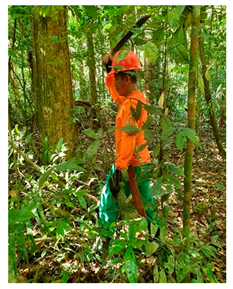 |
|
Scenario 3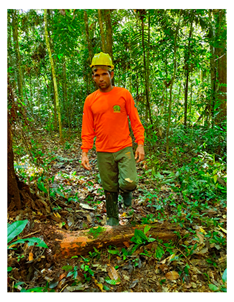 |
|
Scenario 4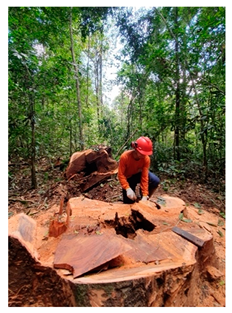 |
|
Scenario 5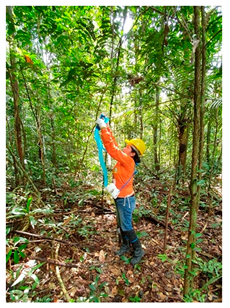 |
|
Scenario 6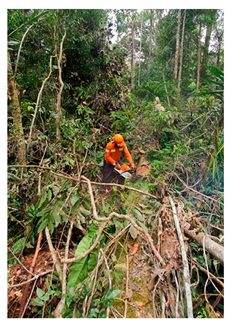 |
|
Scenario 7 |
|
Scenario 8 |
|
Scenario 9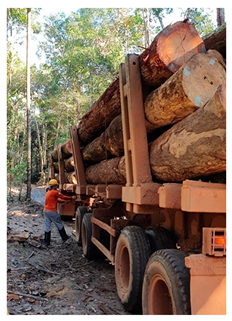 |
|
Scenario 10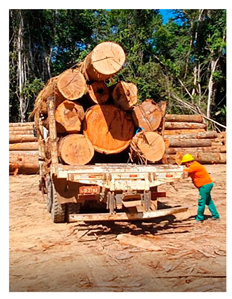 |
|
| Scenario | Danger | Triggering Factor | Risk | Severity (G) | Exposure | Frequency | Risk Control | |||||||||
|---|---|---|---|---|---|---|---|---|---|---|---|---|---|---|---|---|
| MT | OF | WA | RBT | Obst | TS | PI | WI | E | F | RC | ||||||
| 1 | Vegetation | Tractor movement through the vegetation | Get hit by vegetation | 82 | 84 | 73/ 94 | 87 | 87 | 87 | 84 | 93 | 96 | 84 | 86 | ||
| 2 | Tool | Handle tools | Getting hit by the tool’s blade | 91 | 82 | 75/ 91 | 87 | 86 | 87 | 84 | 95 | 91 | 86 | 96 | ||
| 3 | surface obstacles | Overcome obstacles | Tripping or falling | 72/ 94 | 79/ 96 | 76/ 96 | 89 | 84 | 84 | 86 | 95 | 95 | 86 | 89 | ||
| 4 | Branch | Falling branches | Getting hit by a branch | 85 | 86 | 76/ 96 | 95 | 86 | 87 | 93 | 89 | 93 | 86 | 98 | ||
| 5 | Ant | Contact ants | Being stung by ants | 82 | 84 | 82 | 80 | 89 | 87 | 93 | 91 | 82 | 87 | 98 | ||
| 6 | Trunk | Roll the traced trunk over the worker | Being pressed by the torso | 85 | 85 | 76/ 96 | 78/ 96 | 86 | 89 | 93 | 93 | 84 | 87 | 96 | ||
| 7 | Tree partially fallen | Moving the tree with a tractor | Get crushed by the tree | 83 | 91 | 76/ 94 | 87 | 86 | 87 | 91 | 89 | 95 | 87 | 98 | ||
| 8 | Fork loader | Work close to the fork loader | Getting run over by the fork loader | 85 | 85 | 76/ 96 | 80 | 80 | 84 | 95 | 93 | 93 | 86 | 96 | ||
| 9 | Steel cable | Moving machine approach | Trap the fingers between the handle and the log | 83 | 85 | 75/ 98 | 93 | 89 | 86 | 93 | 93 | 96 | 84 | 70 | ||
| 10 | Logs | Handle the steel cable | Being crushed by logs | 80 | 88 | 80 | 75/ 94 | 64 | 84 | 93 | 93 | 95 | 86 | 91 | ||
| Absent/Very-low | Low | Moderate | High | Very-High | ||||||||||||
| MT | OF | WA | RBT | Obst | TS | PI | WI | Ei | Fe | RC | |
|---|---|---|---|---|---|---|---|---|---|---|---|
| Mean ± SD | |||||||||||
| 1st Round | 83 ± 4.8 | 85 ± 3.2 | 77 ± 2.6 | 85 ± 6.5 | 83 ± 7.4 | 86 ± 1.9 | 90 ± 4.2 | 92 ± 1.9 | 92 ± 5.1 | 86 ± 1.3 | 92 ± 8.8 |
| 2nd Round | 85 ± 4.2 | 86 ± 4.1 | 92 ± 6.1 | 89 ± 5.5 | 87 ± 4.1 | 86 ± 1.9 | 90 ± 4.2 | 92 ± 1.9 | 92 ± 5.1 | 86 ± 1.3 | 95 ± 4.4 |
| Scenario | 1 | 2 | 3 | 4 | 5 | 6 | 7 | 8 | 9 | 10 | |||
|---|---|---|---|---|---|---|---|---|---|---|---|---|---|
| Severity sub-parameters (S) | WP * | 0.25 | 1 | 1 | 1 | 1 | 1 | 1 | 1 | 1 | 1 | ||
| TF ** | 8 | 8 | 8 | 8 | 8 | 8 | 8 | 8 | 8 | 8 | |||
| MT | 1 | 4 | 1 | 1 | 2 | 4 | 1 | 8 | 4 | 1 | |||
| OF | 48 | 3 | 6 | 48 | 3 | 12 | 48 | 3 | 3 | 48 | |||
| WA | 0.25 | 0.25 | 0.25 | 0.25 | 0.5 | 0.5 | 0.25 | 0.25 | 0.25 | 0.25 | |||
| RBT | 1 | 0.5 | 0.5 | 0.5 | 1 | 0.5 | 0.5 | 8 | 0.5 | 0.5 | |||
| Obst | 4 | 1 | 1 | 1 | 1 | 1 | 1 | 0.5 | 0.5 | 1 | |||
| TS | 1 | 1 | 4 | 0.5 | 1 | 0.5 | 1 | 0.5 | 0.5 | 0.5 | |||
| PI | 1 | 0.5 | 0.5 | 0.5 | 0.5 | 0.5 | 1 | 0.5 | 0.5 | 0.5 | |||
| WI | 1 | 1 | 1 | 0.5 | 0.5 | 1 | 2 | 1 | 1 | 1 | |||
| Maximum | 48 | 4 | 6 | 48 | 3 | 12 | 48 | 8 | 4 | 48 | |||
| Median | 1.00 | 1.00 | 1.00 | 0.50 | 1.00 | 0.75 | 1.00 | 0.75 | 0.50 | 0.75 | |||
| Severity (Equation (3)) | 96 | 32 | 48 | 192 | 24 | 72 | 384 | 48 | 16 | 288 | |||
| Extent of Impact (Ei) | 4 | 4 | 4 | 4 | 4 | 4 | 4.4 | 4.7 | 4 | 4.0 | |||
| Frequency of Exposure (Fe) | 4 | 5 | 4 | 3.5 | 5 | 4 | 4 | 5 | 3.5 | 3.5 | |||
| Likelihood (Li) (Equation (2)) | 16 | 20 | 16 | 14 | 20 | 16 | 17.6 | 23.5 | 14 | 14 | |||
| Risk Level (RL) (Equation (1)) | 1536 | 640 | 768 | 2688 | 480 | 1152 | 6758.4 | 1128 | 224 | 4032 | |||
| Risk Control (RC) | 0.75 | 0.75 | 0.75 | 0.75 | 0.75 | 0.75 | 0.50 | 0.50 | 0.75 | 0.50 | |||
| Weighted Risk Level (WRL) (Equation (4)) | 1536 | 640 | 768 | 2688 | 480 | 1152 | 6758.4 |  |  | 4032 | |||
| Experts perception |  |  | |||||||||||
| Absent/Very-low | Low | Moderate | High | Very-High | |||||||||
Disclaimer/Publisher’s Note: The statements, opinions and data contained in all publications are solely those of the individual author(s) and contributor(s) and not of MDPI and/or the editor(s). MDPI and/or the editor(s) disclaim responsibility for any injury to people or property resulting from any ideas, methods, instructions or products referred to in the content. |
© 2023 by the authors. Licensee MDPI, Basel, Switzerland. This article is an open access article distributed under the terms and conditions of the Creative Commons Attribution (CC BY) license (https://creativecommons.org/licenses/by/4.0/).
Share and Cite
Lima, K.; Castro, A.C.M.; Santos Baptista, J. MIARforest Reproducibility and Reliability for Assessing Occupational Risks in the Rainforest. Sustainability 2023, 15, 15147. https://doi.org/10.3390/su152015147
Lima K, Castro ACM, Santos Baptista J. MIARforest Reproducibility and Reliability for Assessing Occupational Risks in the Rainforest. Sustainability. 2023; 15(20):15147. https://doi.org/10.3390/su152015147
Chicago/Turabian StyleLima, Killian, Ana C. Meira Castro, and João Santos Baptista. 2023. "MIARforest Reproducibility and Reliability for Assessing Occupational Risks in the Rainforest" Sustainability 15, no. 20: 15147. https://doi.org/10.3390/su152015147
APA StyleLima, K., Castro, A. C. M., & Santos Baptista, J. (2023). MIARforest Reproducibility and Reliability for Assessing Occupational Risks in the Rainforest. Sustainability, 15(20), 15147. https://doi.org/10.3390/su152015147







